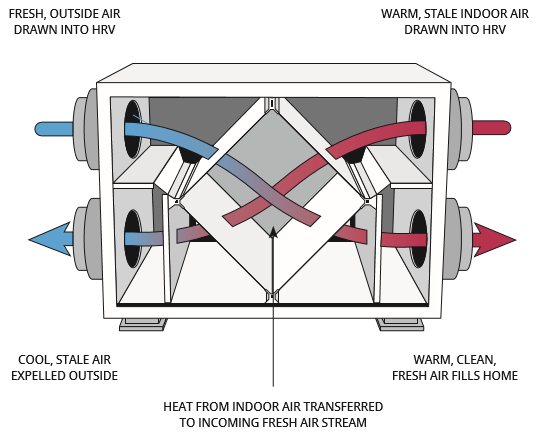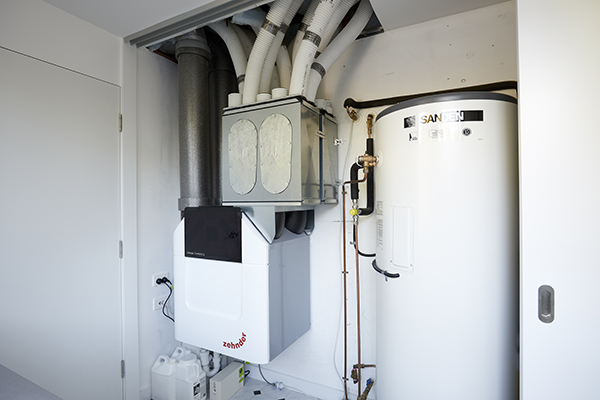7 Signs You Should Consider HRV in Your Home
Wiki Article
Exactly How Heat Recovery Ventilation Boosts Indoor Air Quality and Reduces Power Expenses
Heat Recovery Ventilation (HRV) systems play a crucial duty in enhancing indoor air high quality while concurrently decreasing power expenses. By successfully exchanging stale interior air with fresh outside air, HRVs assist preserve suitable humidity and reduce contaminants. Furthermore, their ability to recoup warmth from outward bound air decreases the pressure on heating and cooling down systems. As power expenses remain to rise, understanding the complete possibility of HRV systems ends up being significantly important for house owners and services alike.Understanding Heat Recovery Ventilation Systems

Heat recovery ventilation (HRV) systems play a vital role in boosting indoor air high quality, particularly in contemporary, energy-efficient structures. These systems are made to move warm from the outbound stagnant air to the incoming fresh air, thereby reducing energy loss while preserving ideal temperature level levels inside your home. HRVs include a warmth exchanger, followers, and ductwork, assisting in the continual circulation of air. By removing interior toxins and presenting fresh air, HRVs help to stabilize humidity degrees, prevent mold and mildew development, and minimize allergens. The effectiveness of HRV systems depends on their ability to recuperate as much as 80% of the warmth from the exhausted air, advertising power preservation while making sure a healthy indoor atmosphere. Their integration is vital in attaining lasting living practices.
The Relevance of Indoor Air Quality
Indoor air quality (IAQ) is a vital element influencing the health and wellness of occupants in any setting. Poor IAQ can bring about various wellness problems, including respiratory system troubles, allergies, and tiredness. Additionally, it can exacerbate status quo such as bronchial asthma. Elements adding to low IAQ include pollutants from indoor sources like cleaning representatives, mold, and poor air flow. Keeping good IAQ is important for promoting a risk-free and comfortable living or working room. Efficient approaches to enhance IAQ involve normal surveillance of air high quality, proper ventilation systems, and decreasing making use of unsafe materials indoors. By focusing on IAQ, individuals can guarantee a healthier environment that promotes productivity and general quality of life.Energy Efficiency Benefits of HRV Systems
Numerous property owners and building managers are increasingly recognizing the power effectiveness benefits of warm healing ventilation (HRV) systems. By moving warmth from exhausted indoor air to incoming fresh air, HRV systems markedly reduce the power needed for cooling and heating. This procedure reduces reliance on typical HVAC systems, causing lower power expenses. In addition, HRVs help preserve a well balanced indoor environment, preventing excessive home heating or cooling needs. The capability to recoup approximately 90% of the warm from outgoing air likewise supports sustainability efforts by minimizing total energy consumption. HRV systems add not only to cost savings however likewise to a reduced carbon impact, lining up with the expanding focus on energy-efficient structure techniques.Installment and Upkeep Considerations
The effective execution of warm recovery air flow (HRV) systems calls for careful factor to consider of setup and upkeep factors to guarantee peak performance. Proper positioning of the HRV unit is crucial, as it must be mounted in an area that optimizes air flow while lessening sound interruption. Furthermore, ductwork has to be properly sized and protected to stop energy loss. Regular maintenance, consisting of filter substitute and system cleansing, is critical to safeguard optimum functionality and interior air high quality. Owners ought to establish a normal upkeep timetable to determine and attend to potential concerns before they escalate. Cooperation with seasoned professionals during both installment and upkeep stages can enhance the durability and effectiveness of HRV systems, eventually leading to far better indoor environments and minimized power expenses.
Real-World Applications and Success Stories
Exploring real-world applications of warm recovery air flow (HRV) systems reveals their considerable effect on indoor air quality and power efficiency across numerous settings. In domestic structures, property owners have actually reported enhanced air top quality, resulting in less allergies and respiratory system issues. Schools applying HRV systems have actually kept in mind improved student focus and reduced absenteeism because of much better air flow. Business buildings, such as offices and retail areas, have actually experienced reduced energy costs and raised staff member efficiency. As an example, a company workplace in a pleasant environment accomplished a 30% decrease in power bills after installing an HRV system. These success tales show that HRV technology not just adds to much HRV Heat Recovery Ventilation healthier environments but likewise gives concrete financial benefits, making it a beneficial financial investment for various fields.Regularly Asked Concerns
Can HRV Equipments Minimize Irritants in Indoor Air?
The performance of HRV systems in minimizing interior allergens largely depends upon their ability to filter and exchange air. HRV Heat Recovery Ventilation. By continuously replacing stale air, these systems can considerably reduce irritant levels throughout indoor settings
Exactly How Does Moisture Affect HRV System Performance?
Humidity greatly influences HRV system efficiency; high degrees can result in condensation, lowering efficiency, while low moisture may enhance air exchange. Balancing moisture is necessary for optimal operation and preserving indoor air quality.Are HRV Solutions Noisy During Operation?
HRV systems can generate differing noise degrees during operation, relying on their layout and installation. Some systems operate silently, while others may generate visible audio, especially at greater airflow settings or when improperly kept.What Is the Average Life Expectancy of an HRV System?

Can HRV Systems Be Utilized in All Environments?
HRV systems can be used in numerous climates, however their effectiveness might differ - HRV Heat Recovery Ventilation. In extreme temperatures, changes or supplementary systems could be necessary to assure ideal efficiency and comfort while keeping interior air qualityReport this wiki page